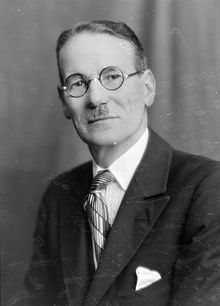Bob Semple
Bob Semple | |
|---|---|
 Bob Semple in 1935 | |
| 14th Minister of Railways | |
| In office 12 December 1941 – 12 December 1949 | |
| Prime Minister | Peter Fraser |
| Preceded by | Dan Sullivan |
| Succeeded by | William Goosman |
| 7th President of the Labour Party | |
| In office 1926–1928 | |
| Vice President | Jim Thorn (1926-7) John Archer (1927-8) |
| Leader | Harry Holland |
| Preceded by | Tom Brindle |
| Succeeded by | John Archer |
| Member of the New Zealand Parliament for Wellington South | |
| In office 1918–1919 | |
| Preceded by | Alfred Hindmarsh |
| Succeeded by | George Mitchell |
| Member of the New Zealand Parliament for Wellington East | |
| In office 1928–1946 | |
| Member of the New Zealand Parliament for Miramar | |
| In office 1946–1954 | |
| Succeeded by | Bill Fox |
| Personal details | |
| Born | 21 October 1873 Sofala, New South Wales, Australia |
| Died | 31 January 1955 (aged 81) New Plymouth, New Zealand |
| Political party | Labour |
| Spouse | Margaret Semple |
Robert Semple (21 October 1873 – 31 January 1955) was a union leader and later Minister of Public Works for the first Labour Government of New Zealand.
Early life
He was born in Sofala, New South Wales, Australia. He started working at an early age as gold miner in Australia. In 1903 he was involved in a miner's strike in Victoria Australia. The strike was defeated and Semple ended up being blacklisted.[1]
To avoid the blacklist Semple moved to the West Coast of the South Island of New Zealand. By 1907 he was president of the Runanga Miner's Union and earned himself nickname 'Fighting Bob Semple'.
He was jailed in 1913 for supporting the general strike and again in 1916 after fighting conscription for overseas service during World War I. Semple served as the President of the Labour Party from 1926 to 1928.[2]
Semple was a member of the Wellington City Council for a decade between 1925 and 1935. In 1935 he unsuccessfully stood for Mayor of Wellington, coming runner-up to Thomas Hislop.[3] His wife Margaret was also a Wellington City Councillor from 1938 to 1941.[4]
Parliamentary career
| Years | Term | Electorate | Party | ||
|---|---|---|---|---|---|
| 1918–1919 | 19th | Wellington South | Labour | ||
| 1928–1931 | 23rd | Wellington East | Labour | ||
| 1931–1935 | 24th | Wellington East | Labour | ||
| 1935–1938 | 25th | Wellington East | Labour | ||
| 1938–1943 | 26th | Wellington East | Labour | ||
| 1943–1946 | 27th | Wellington East | Labour | ||
| 1946–1949 | 28th | Miramar | Labour | ||
| 1949–1951 | 29th | Miramar | Labour | ||
| 1951–1954 | 30th | Miramar | Labour | ||
Semple was elected to the seat of Wellington South Parliament for Labour in a 1918 by-election, but lost the seat in the 1919 general election. In 1928 he won the Wellington East seat, and held it until 1946, when it was renamed Miramar. He then held Miramar until 1954, when he retired.[5]
In 1935, he was awarded the King George V Silver Jubilee Medal.[6]
During his term in Parliament, Semple held many important infrastructure portfolios, such as Minister of Public Works (1935–1941, 1942–1943) and Minister of Railways (1941–1949).[7] Semple was seen by many as the public face of the first Labour government's infrastructure investment. During World War II he designed and had built the 'Bob Semple tank', made from corrugated iron and a tractor base. The tank had numerous design flaws and other practical problems and was never put into production, although it was and continues to be regarded with affection by many New Zealanders.
He did not seek re-election in the 1954 election, and died in New Plymouth in January 1955.
Notes
- ^ Richardson, Len. "Semple, Robert". Dictionary of New Zealand Biography. Ministry for Culture and Heritage. Retrieved 30 December 2013.
- ^ Paul, J.T. (1946). Humanism in Politics: New Zealand Labour Party in Retrospect. Wellington, NZ: New Zealand Worker Printing and Publishing. p. 192.
- ^ "Polling in Wellington". The New Zealand Herald. Vol. LXXII, no. 22105. 10 May 1935. p. 13. Retrieved 2 August 2016.
- ^ Wellington: Biography of a city by Redmer Yska (Reed, Auckland, 2006) page 159 ISBN 0-7900-1117-4
- ^ Wilson 1985, p. 233.
- ^ "Official jubilee medals". The Evening Post. 6 May 1935. p. 4. Retrieved 30 August 2013.
- ^ Wilson 1985, pp. 82f.
External links
"1938, photo of presentation to Bob Semple". Papers Past. 1 December 2015.
References
- Hickey, Carina (2010). From Coal Pit to Leather Pit: Life Stories of Robert Semple (PDF) (Ph.D.). Massey University. Retrieved 17 March 2015.
{{cite thesis}}: Invalid|ref=harv(help) - Wilson, James Oakley (1985) [First published in 1913]. New Zealand Parliamentary Record, 1840–1984 (4th ed.). Wellington: V.R. Ward, Govt. Printer. OCLC 154283103.
{{cite book}}: Invalid|ref=harv(help)
- Use dmy dates from September 2011
- 1873 births
- 1955 deaths
- New Zealand Labour Party MPs
- People from the Central West (New South Wales)
- Australian emigrants to New Zealand
- Members of the Cabinet of New Zealand
- New Zealand trade unionists
- New Zealand conscientious objectors
- Members of the New Zealand House of Representatives
- New Zealand MPs for Wellington electorates
- Unsuccessful candidates in the New Zealand general election, 1919
- Unsuccessful candidates in the New Zealand general election, 1925
- New Zealand politicians convicted of crimes
- Social Democratic Party (New Zealand) politicians
- Wellington City Councillors
- New Zealand Socialist Party politicians
- Wellington Harbour Board members
- New Zealand anti–World War I activists
